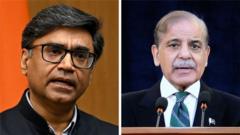Despite ongoing tensions, experts believe the risk of nuclear war remains low, thanks to deterrence strategies and diplomatic channels.
**Nuclear Risk: A Close Look at India-Pakistan Tensions**

**Nuclear Risk: A Close Look at India-Pakistan Tensions**
The increasing military posturing raises questions about the potential for nuclear conflict between India and Pakistan.
In the context of the latest standoff between India and Pakistan, the threat of nuclear conflict has emerged again, albeit without ultimatums or direct military escalation. This latest crisis, while reportedly contained by US intervention, underscores the volatility of the regional relationship and the potential for rapid deterioration. A 2019 study highlighting a hypothetical nuclear exchange sparked by a terrorist attack on India's parliament in 2025 emphasizes just how precarious the balance of power is in South Asia.
At the center of the tension is Pakistan’s calculated military response, which included a meeting of its National Command Authority (NCA) amid the crisis. This response serves as a reminder of Pakistan's nuclear capabilities, generating widespread concern as the two nations are known to each possess approximately 170 nuclear warheads, according to the Stockholm International Peace Research Institute.
Indian Prime Minister Narendra Modi has reinforced India's stance against nuclear threats, proclaiming a zero-tolerance policy towards nuclear blackmail. While India's nuclear doctrine asserts a no-first-use policy, caveats have emerged over time that suggest a potential softening of this position, particularly in response to bioweapons or chemical threats. Conversely, Pakistan has not established a formal nuclear doctrine but has communicated operational principles through various statements from its officials.
Experts from the University of Albany and Carnegie Endowment for International Peace assert that the risk of nuclear escalation remains manageable, particularly in the absence of significant ground combat. According to Christopher Clary, understanding the concept of “use it or lose it” adds a dimension of urgency in high-stress situations where conventional forces may be engaged.
Accidents pose another layer of threat; a mishap involving a misfired Indian missile into Pakistan exemplifies the latent dangers that could escalate tensions if not carefully managed. While this incident was resolved without major fallout, it illustrates how easily situations can spiral out of control, especially with both nations strengthening their nuclear arsenals.
Analysts maintain that the inherent risks of nuclear war, while present, are relatively limited due to the mutual understanding of the catastrophic consequences of a first-use scenario. Despite this, increasing developments in both nations’ nuclear capabilities highlight the persistent dangers tied to their geopolitical disputes. In this nuclear age, minimizing risk is paramount, but as John Erath notes, even a small risk can have disproportionate consequences in the context of nuclear weapons. The existing deterrence mechanisms may be holding, but vigilance remains essential in safeguarding regional peace.
At the center of the tension is Pakistan’s calculated military response, which included a meeting of its National Command Authority (NCA) amid the crisis. This response serves as a reminder of Pakistan's nuclear capabilities, generating widespread concern as the two nations are known to each possess approximately 170 nuclear warheads, according to the Stockholm International Peace Research Institute.
Indian Prime Minister Narendra Modi has reinforced India's stance against nuclear threats, proclaiming a zero-tolerance policy towards nuclear blackmail. While India's nuclear doctrine asserts a no-first-use policy, caveats have emerged over time that suggest a potential softening of this position, particularly in response to bioweapons or chemical threats. Conversely, Pakistan has not established a formal nuclear doctrine but has communicated operational principles through various statements from its officials.
Experts from the University of Albany and Carnegie Endowment for International Peace assert that the risk of nuclear escalation remains manageable, particularly in the absence of significant ground combat. According to Christopher Clary, understanding the concept of “use it or lose it” adds a dimension of urgency in high-stress situations where conventional forces may be engaged.
Accidents pose another layer of threat; a mishap involving a misfired Indian missile into Pakistan exemplifies the latent dangers that could escalate tensions if not carefully managed. While this incident was resolved without major fallout, it illustrates how easily situations can spiral out of control, especially with both nations strengthening their nuclear arsenals.
Analysts maintain that the inherent risks of nuclear war, while present, are relatively limited due to the mutual understanding of the catastrophic consequences of a first-use scenario. Despite this, increasing developments in both nations’ nuclear capabilities highlight the persistent dangers tied to their geopolitical disputes. In this nuclear age, minimizing risk is paramount, but as John Erath notes, even a small risk can have disproportionate consequences in the context of nuclear weapons. The existing deterrence mechanisms may be holding, but vigilance remains essential in safeguarding regional peace.





















